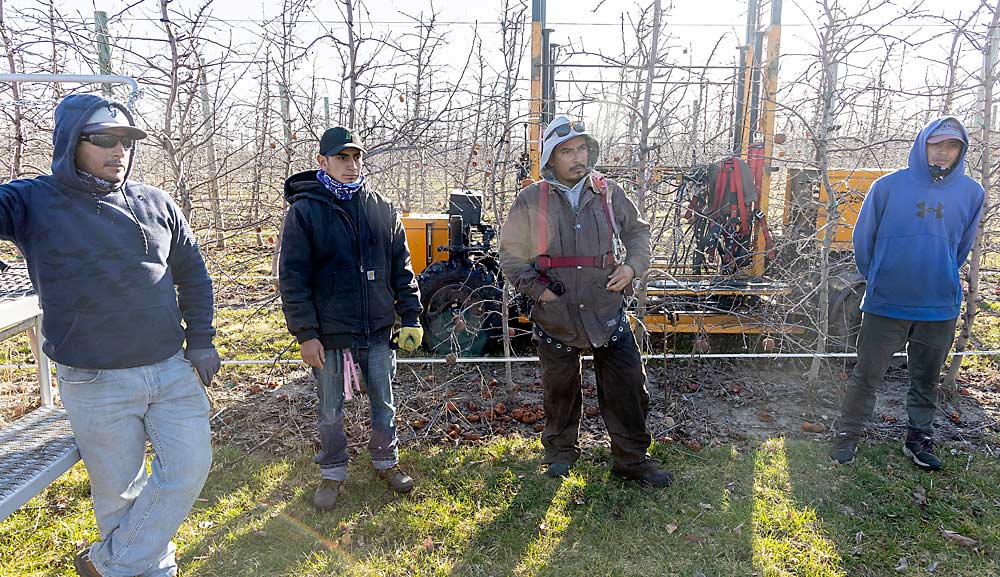[ad_1]
—story and photographs by Matt Milkovich

Growers in Michigan’s Fruit Ridge orchard area north of Grand Rapids began this rising season with loads to fret about. Markets have been nonetheless glutted with apples after a giant 2023 crop, and costs have been low. Bushes have been budding early after a particularly heat winter, and everybody was anticipating a protracted spring of potential crop-killing freezes.
However at Joe Rasch Orchards and different apple farms that rent H-2A staff, there have been extra existential worries as properly. If the federal guest-worker program’s wage charge continues to skyrocket and the worth of apples continues to say no, a lot of these orchards gained’t be round for much longer, mentioned Katie and Manuel Vargas, who run the household orchard with Katie’s dad and mom, Joe and Mary Rasch.
Throughout a March go to with Good Fruit Grower, Katie, who’s change into one thing of an unofficial spokesperson for the Michigan apple trade, mentioned that if the H-2A program’s Adversarial Impact Wage Charge — meant to guard home staff from “antagonistic results” attributable to the presence of H-2A staff — isn’t fastened quickly, or no less than frozen in place, there might be a wave of “For Sale” indicators going up on the Ridge within the subsequent yr or two.
She’s not the one one sounding the alarm.
“The Michigan apple trade is in danger,” mentioned Diane Smith, government director of the Michigan Apple Committee. “I’m listening to from growers throughout Michigan, telling me their farms gained’t survive.”
Katie mentioned that growers are used to intervals of low-priced fruit; mixed with a Michigan AEWR of $18.50 per hour in 2024, nevertheless, the scenario has change into dire. Trade teams throughout the nation are pushing for presidency reduction. U.S. Rep. John Moolenaar, whose district consists of the Fruit Ridge, launched a invoice in January that might freeze the AEWR by 2025, however the trade additionally needs a long-term answer that might require a congressional overhaul of the H-2A program.
“I believe it could actually get solved,” she mentioned. “I simply don’t know if it’s going to be quick sufficient.”

Joe Rasch Orchards was one of many first Michigan apple employers to rent H-2A staff in 2014, as a part of a pilot program organized by Michigan Farm Bureau. At the moment, Michigan’s AEWR was $11.49 per hour. After studying from that have, Katie spent the subsequent 5 years working for Nice Lakes Ag Labor Companies, an company created by Michigan Farm Bureau to assist farmers navigate the H-2A program.
She mentioned the growers she labored with had a “love/hate” relationship with H-2A. A number of the program’s crimson tape has been streamlined over time, however growers are nonetheless coping with a number of federal and state businesses and a whole lot of paperwork. However, H-2A supplied them with a talented, dependable workforce that confirmed up yearly.
“For a time, it let (growers) see a future,” Katie mentioned. “You’re getting fruit off on time, getting higher packouts, higher high quality — however there was at all times an underlying concern concerning the wage getting to some extent the place it’s unsustainable. That’s the place they’re now.”
Smith mentioned Michigan’s AEWR has gone up 61 p.c prior to now decade. The state’s apple growers employed an estimated 5,200 H-2A staff in 2023.
Driving by the household orchard, Manuel Vargas mentioned enter prices normally have gone up, whereas apple costs are decrease than they have been three years in the past. As he drove by a block of previous, freestanding bushes, Empire and Crimson Scrumptious, Manuel mentioned he want to pull them out and put in a extra fashionable planting, however they’ll’t afford it.
A crew of H-2A staff took a break from pruning to reply a couple of questions. Katie and Manuel translated. The pruners mentioned the H-2A program gives them with good work, they usually need the orchard to outlive so the work can proceed.
“We want these individuals,” Manuel mentioned. “They’re not taking jobs from anyone.”

Native individuals not often apply for orchard work, and Joe Rasch Orchards spent years counting on migrant labor. That modified after 2012, when an early spring adopted by freeze occasions nearly worn out Michigan’s apple crop. They didn’t have a lot work to supply that yr, and never sufficient staff confirmed up the next yr. That’s after they determined to strive H-2A. Like a whole lot of orchards, they’ve come to depend on H-2A staff to outlive, Katie mentioned.
Final yr, they employed about 75 H-2A staff to handle their 450 acres of apples, and about 25 H-2A staff for the packing home, the place they work alongside home staff, she mentioned.
Katie has used her H-2A information to petition lawmakers and officers in Washington, D.C. She was there once more in March, searching for program modifications alongside the U.S. Apple Affiliation.
She encourages different growers to become involved, too. Through the Michigan Pomesters’ Ridgefest final summer season, she informed the gathering that trade messages are more practical if they arrive instantly from growers.
“There’s a whole lot of loud voices that say (H-2A is) not program, however I do know that’s not the scenario on our farms,” she mentioned. “If we don’t make our tales heard, the one tales individuals will hear are the unhealthy ones. And that turns into their fact.” •
[ad_2]

